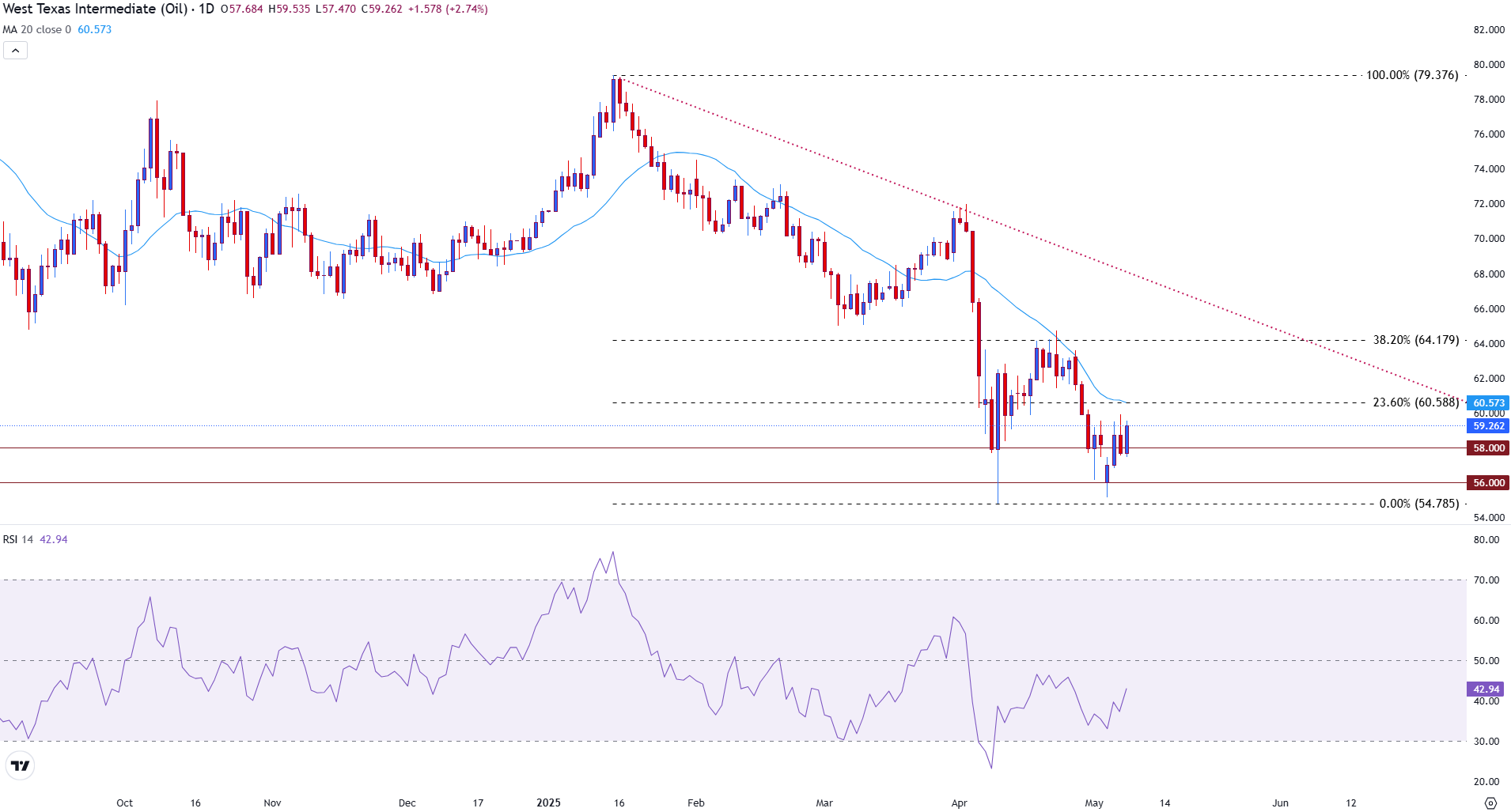- The WTI recovers after the fall in US inventories for the second consecutive week, pointing out a more adjusted supply.
- Commercial conversations between the US and China will resume this weekend, improving demand outlook in the midst of global appetite due to risk.
- The WTI approaches the key psychological resistance zone of 60.00, with the 20 -day SMA and the Fibonacci level of 23.6% as key obstacles to more profits.
WTI crude oil is quoting in strong rise on Thursday, since oil prices benefit from the combination of the fall in inventories in the United States (USA) and the growing optimism around the next commercial conversations between the US and China, which have elevated the hopes of a possible descaled in the tensions between the two largest economies in the world.
At the time of writing, the WTI has risen 2.83% to $ 59.33, extending its rebound from the previous minimums and recovering lost ground in April.
US inventories record the second weekly fall, adjusting the perspectives
This week’s rebound has been driven by consecutive reductions in inventories, reinforcing the signals of a more adjusted American oil market.
On Tuesday, the American Petroleum Institute (API) – an industry agency that issues early supply estimates – reported that US crude oil inventories fell by 4.49 million barrels for the week that ended on May 3, far exceeding the expected reduction of 2.5 million barrels. This followed a surprising increase of 3.76 million barrels the previous week.
The official data of the US Energy Information Administration (EIA) published on Wednesday showed a decrease of 2.03 million barrels, slightly below consensus forecasts. This was the second consecutive weekly fall after a reduction of 2,696 million barrels the previous week. Despite the government inferior figure than expected, consecutive falls confirm a more adjusted supply or a demand in improvement, both factors that support higher prices.
Commercial conversations between the US and China revive demand optimism
On Tuesday, the US government confirmed that Treasury Secretary Scott Besent and trade representative Jamieson Greer will travel to Switzerland this weekend to meet with Chinese officials, marking the first formal commercial negotiations in more than three months.
The announcement improved the feeling of the market, since the operators interpreted the conversations as a sign that the tariff pressure could be relieved. Any progress towards improved industrial relations or the reduction of commercial barriers would probably strengthen the global oil demand, especially given the role of China as the largest importer of oil.
Opec +’s policy remains a stabilizing background
Although it is not a new development, Opec+ production policy continues to support market expectations. On Saturday, the key producers of the coalition, including Saudi and Russia Arabia, agreed to increase production by 411,000 barrels per day in June as part of a gradual setback of the previous volunteer cuts.
However, the group emphasized that the decision remains flexible, with possible adjustments if the market conditions deteriorate. Opec+ will reassess its policy at its next meeting on June 1 and reiterated its commitment to avoid excess supply.
The WTI challenges the 60.00 psychological barrier
WTI crude oil is quoting about $ 59.35, pushing towards a key resistance zone as the impulse improves. The immediate rising potential is limited at the psychological level of $ 60.00, which also closely aligned with the 20 -day mobile average in $ 60.58 and the fibonacci setback of 23.60% of the fall of 2025. This confluence around 60.00 –60.60 $ marks a critical test for the bullies.
A sustained rupture above this area would open the door towards the resistance of the descending trend line about $ 62.00, followed by the 38.20% setback in 64.18 $. Downwards, the initial support is located at $ 58.00, with a greater purchase interest expected in $ 56.00, and an important support resting in the recent minimum of 54.79 $.
The Relative Force Index (RSI) has risen to 43.23, showing a bearish impulse that vanishes but still lacking confirmation of a complete uprising reversal. A daily closure above $ 60.60 would probably indicate the start of a more sustained recovery.
WTI crude oil daily graphics

WTI FAQS oil
WTI oil is a type of crude oil that is sold in international markets. WTI are the acronym of West Texas Intermediate, one of the three main types that include the Brent and Dubai’s crude. The WTI is also known as “light” and “sweet” by its relatively low gravity and sulfur content, respectively. It is considered high quality oil that is easily refined. It is obtained in the United States and is distributed through the Cushing Center, considered “the crossing of the world.” It is a reference for the oil market and the price of WTI is frequently traded in the media.
Like all assets, supply and demand are the main factors that determine the price of WTI oil. As such, global growth can be a driver of the increase in demand and vice versa in the case of weak global growth. Political instability, wars and sanctions can alter the offer and have an impact on prices. OPEC decisions, a group of large oil -producing countries, is another key price factor. The value of the US dollar influences the price of WTI crude oil, since oil is mainly traded in US dollars, so a weaker dollar can make oil more affordable and vice versa.
Weekly reports on oil inventories published by the American Petroleum Institute (API) and the Energy Information Agency (EIA) influence the price of WTI oil. Changes in inventories reflect the fluctuation of supply and demand. If the data show a decrease in inventories, it can indicate an increase in demand, which would raise the price of oil. An increase in inventories may reflect an increase in supply, which makes prices lower. The API report is published every Tuesday and that of the EIA the next day. Their results are usually similar, with a 1% difference between them 75% of the time. EIA data is considered more reliable, since it is a government agency.
The OPEC (Organization of Petroleum Exporting Countries) is a group of 13 nations oil producing that collectively decide the production quotas of member countries in biannual meetings. Their decisions usually influence WTI oil prices. When OPEC decides to reduce fees, it can restrict the supply and raise oil prices. When OPEC increases production, the opposite effect occurs. The OPEC+ is an expanded group that includes another ten non -members of the OPEC, among which Russia stands out.
Source: Fx Street
I am Joshua Winder, a senior-level journalist and editor at World Stock Market. I specialize in covering news related to the stock market and economic trends. With more than 8 years of experience in this field, I have become an expert in financial reporting.







